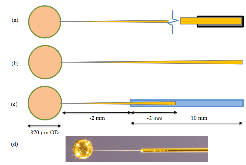Evaluation of Direct Drive Capsule Fill-Tube Assembly Survivability in Support of the 100 GBar Campaign
- General Atomics, San Diego, CA (United States)
- Univ. of Rochester, NY (United States). Lab. for Laser Energetics
Capsule fill-tube target assemblies (CFTAs) for direct-drive have been demonstrated in the past for Laser for Laboratory Energetics (LLE) cryogenic layering studies, evolving and building upon successful deliveries for NIF. The current 100 GigaBar (GBar) campaign requires increased tolerances over prior CFTA work in terms of robustness, cleanliness, reduced fill tube diameter and glue size. To tackle these challenges, GA and LLE are developing a direct drive CFTA that survives all fabrication activities, from assembly, qualification testing and transport to cryogenic layering and target chamber insertion at the OMEGA laser facility. Approximately 55 CFTAs of two main designs have been constructed and tested to date, building off the current LLE cryogenic layering study CFTA design (typically 870 µm diameter x 25 µm thick wall capsule). Variations of glass fill tubes sizes from 30, 20 and 10 µm diameter, which are inserted and glued into the capsule. Testing protocols were developed to enable comparison of different designs against one another and evaluate their robustness at room temperature. The testing protocols include pressure checks, resonant vibration mode sweeps, runout and vibration testing to a power spectral density (PSD) input. In this paper we will compare the different design tradeoffs, measurements and results including glue fillets, sag of the fill tubes under gravity, runout and hysteresis, ringdown response, X-ray imaging of the pipette wall thicknesses, and scanning electron microscope (SEM) images taken of failed fill tubes and glue joints. Assessment of the modal vibration modeling for the designs will be compared against the vibration data. Lastly, a design recommendation is put forth meeting the design constraints, which consists of a polymicro composite tube and 10 µm fill tube, ensuring survivability at cryogenic temperatue, a higher first mode resonance and smaller fuel volume.
- Research Organization:
- General Atomics, San Diego, CA (United States)
- Sponsoring Organization:
- USDOE
- Grant/Contract Number:
- NA0001808
- OSTI ID:
- 1462722
- Journal Information:
- Fusion Science and Technology, Vol. 73, Issue 2; ISSN 1536-1055
- Publisher:
- American Nuclear SocietyCopyright Statement
- Country of Publication:
- United States
- Language:
- English
Web of Science
Robust Capsule and Fill Tube Assemblies for the National Ignition Campaign
|
journal | April 2009 |
Fill Tube Assembly Development for Omega and NIF Shell Applications
|
journal | April 2009 |
Improvements to Fill Tube Design for Direct-Drive NIF and Fast Ignition Applications
|
journal | January 2011 |
Similar Records
Targets for the National Ignition Campaign
Achieving 280 Gbar hot spot pressure in DT-layered CH capsule implosions at the National Ignition Facility










